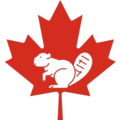Portal:Canada
| Showcase | Contents | Contributing |
Introduction
Canada is a country in North America. Its ten provinces and three territories extend from the Atlantic Ocean to the Pacific Ocean and northward into the Arctic Ocean, making it the world's second-largest country by total area, with the world's longest coastline. Its border with the United States is the world's longest international land border. The country is characterized by a wide range of both meteorologic and geological regions. With a population of just over 41 million people, it has widely varying population densities, with the majority residing in urban areas and large areas of the country being sparsely populated. Canada's capital is Ottawa and its three largest metropolitan areas are Toronto, Montreal, and Vancouver.
A developed country, Canada has a high nominal per capita income globally and its advanced economy ranks among the largest in the world by nominal GDP, relying chiefly upon its abundant natural resources and well-developed international trade networks. Recognized as a middle power, Canada's support for multilateralism and internationalism has been closely related to its foreign relations policies of peacekeeping and aid for developing countries. Canada promotes its domestically shared values through participation in multiple international organizations and forums. (Full article...)
Featured article -

"In Flanders Fields" is a war poem in the form of a rondeau, written during the First World War by Canadian physician Lieutenant-Colonel John McCrae. He was inspired to write it on May 3, 1915, after presiding over the funeral of friend and fellow soldier Lieutenant Alexis Helmer, who died in the Second Battle of Ypres. According to legend, fellow soldiers retrieved the poem after McCrae, initially dissatisfied with his work, discarded it. "In Flanders Fields" was first published on December 8 of that year in the London magazine Punch. Flanders Fields is a common English name of the World War I battlefields in Belgium and France. (Full article...)
Current events
- April 21, 2025 –
- ARK Invest becomes the first US-based asset manager to gain exposure to the Solana blockchain through an ETF investment after Canada approves several spot Solana ETFs. (Coin Market Cap)
- April 16, 2025 – Tariffs in the second Trump administration
- California Governor Gavin Newsom and California Attorney General Rob Bonta file a lawsuit against U.S. President Donald Trump and his administration over the tariffs, making California the first U.S. state to do so. The lawsuit also targets the International Economic Emergency Powers Act, the law used by Trump to impose tariffs against Canada, China, and Mexico. (Politico)
- April 15, 2025 –
- Four people are injured in a vehicle-ramming attack after a person drives a sedan onto a pedestrian walkway on the Toronto Metropolitan University campus near Yonge Street and Gerrard Street in Toronto, Ontario, Canada. (CBC News)
- April 9, 2025 – Tariffs in the second Trump administration, Executive orders in the second presidency of Donald Trump
- Canada announces a 25% tariff on certain vehicle imports from the U.S. as retaliation against a previous similar measure from the U.S. (BBC News)
- April 3, 2025 – Tariffs in the second Trump administration
- Multinational car manufacturer Stellantis announces it will lay off 900 workers across five of its U.S. factories and will pause production at assembly plants in Canada and Mexico in response to the tariffs. (Reuters)
- April 3, 2025 – Canada convoy protests
- The Ontario Court of Justice in Ontario, Canada, convicts Tamara Lich and Chris Barber, two leaders of the truck driver protest movement against COVID-19 vaccination in Canada, of criminal mischief. (AP)
National symbol -
Parliament Hill (French: Colline du Parlement), colloquially known as The Hill, is an area of Crown land on the southern bank of the Ottawa River that houses the Parliament of Canada in downtown Ottawa, Ontario. It accommodates a suite of Gothic revival buildings whose architectural elements were chosen to evoke the history of parliamentary democracy. Parliament Hill attracts approximately three million visitors each year. The Parliamentary Protective Service is responsible for law enforcement on Parliament Hill and in the parliamentary precinct, while the National Capital Commission is responsible for maintaining the nine-hectare (22-acre) area of the grounds. (Full article...)
Selected vital article -

The monarchy of Canada is Canada's form of government embodied by the Canadian sovereign and head of state. It is one of the key components of Canadian sovereignty and sits at the core of Canada's constitutional federal structure and Westminster-style parliamentary democracy. The monarchy is the foundation of the executive (King-in-Council), legislative (King-in-Parliament), and judicial (King-on-the-Bench) branches of both federal and provincial jurisdictions. The current monarch is King Charles III, who has reigned since 8 September 2022. (Full article...)
Selected picture -
Featured biography -
Ida Joséphine Phoebe Éva Gauthier (September 20, 1885 – December 20 or 26, 1958) was a Canadian-American mezzo-soprano and voice teacher. She performed and popularized songs by contemporary composers throughout her career and sang in the American premieres of several works by Erik Satie, Maurice Ravel and Igor Stravinsky, including the title role in the latter's Perséphone. (Full article...)
Did you know -

- ... that as of 2019, inclusion in the International Register of Electors no longer requires residency in Canada in the preceding five years?
- ... that a year after becoming the first woman president of the Canadian Political Science Association, Caroline Andrew moderated the first Canadian leaders' debate on women's issues?
- ... that Darryl Milburn made his Canadian Football League debut on his birthday, but did not appear in any other games that year?
- ... that the first Miss Indigenous Canada contestants were judged on ambassadorship, character, community service, and cultural involvement?
- ... that the Otoskwin–Attawapiskat River Provincial Park, protecting the Otoskwin and Attawapiskat Rivers in Ontario, Canada, has archaeological and historical sites dating from 3000 BC to the 1800s?
- ... that journalist Jacques Poitras spent a month repeatedly crossing the "Imaginary Line" separating New Brunswick and Maine in order to publish a book about it?
- ... that the Oxtongue River, historically a canoe route for indigenous people, is still used for recreational canoeing?
Featured list -
Like most major cities, Montreal needs easy highway access from its suburbs and surrounding areas. However, because Montreal was built on an island surrounded by three rivers, it can be entered by land only on a bridge or through a tunnel. Although the city was founded in 1642, it was not until 1847 that the first fixed link to the outside was established when a wooden bridge was built across Rivière des Prairies to Île Jésus, on the site of what is now Ahuntsic Bridge. Another bridge was built immediately afterward, a few kilometers west, which became Lachapelle Bridge, and another in 1849, Pont des Saints-Anges, to the east. The latter bridge collapsed in the 1880s and was never rebuilt. (Full article...)
Main articles
Associated Wikimedia
The following Wikimedia Foundation sister projects provide more on this subject:
-
Commons
Free media repository -
Wikibooks
Free textbooks and manuals -
Wikidata
Free knowledge base -
Wikinews
Free-content news -
Wikiquote
Collection of quotations -
Wikisource
Free-content library -
Wikiversity
Free learning tools -
Wikivoyage
Free travel guide -
Wiktionary
Dictionary and thesaurus






























